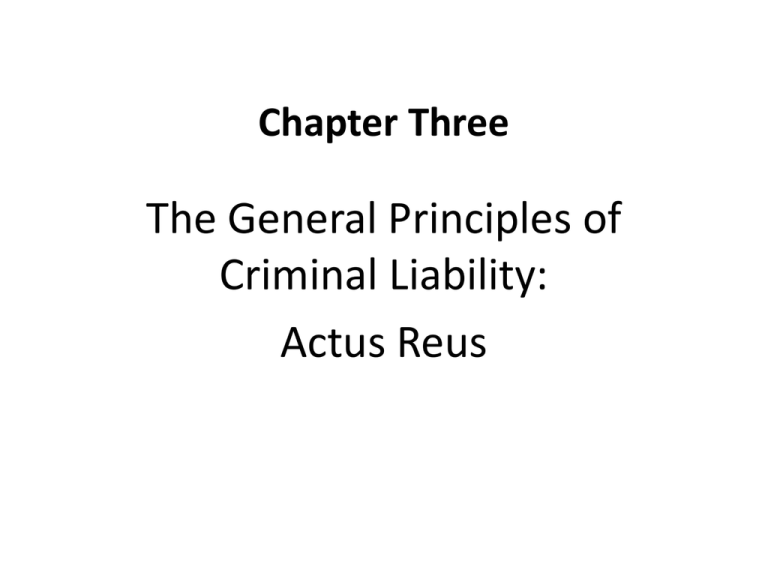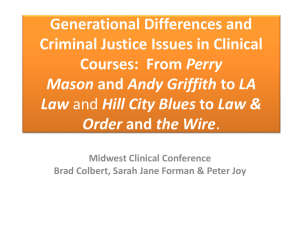
Chapter Three
The General Principles of
Criminal Liability:
Actus Reus
Learning Objectives
• To be able to identify the elements of, and to
explain why, the voluntary act is the first
principle of criminal liability.
• To be able to define, distinguish between, and
understand the importance of the elements of
criminal conduct and criminal liability and
therefore punishment.
• To understand and appreciate the importance
of the requirement of a voluntary act.
Learning Objectives
• To identify the circumstances when, and to be
able to explain why, status is treated,
sometimes, as an affirmative act.
• To be able to understand how the general
principle of actus reus includes a voluntary act
and how it is viewed by the constitution.
Learning Objectives
• To identify the circumstance when, and to be
able to explain why, failures to act are treated
as affirmative acts.
• To understand and identify the circumstances
when, and to be able to explain why,
possession is treated as an act.
Voluntary act is the first principle of
criminal liability
• In order to have criminal liability there must
be criminal conduct
• Criminal conduct is conduct that is without
justification and without excuse
• Voluntary act is the “conduct” part of criminal
conduct
• Many crimes don’t include a criminal intent or
bad result, but only rarely does a crime not
require a criminal act
Elements of Criminal Liability
• Actus Reus—the criminal act
• Mens rea—the criminal intent
• Concurrence—the requirement that the
criminal intent trigger the criminal act
• Attendant circumstances (when a crime does
not require the mens rea, it generally requires
some attendant circumstance)
– Example: DWI
• Bad result--causing a criminal harm
Elements of Criminal Liability
(continued)
• Corpus delicti = “body of crime” but it doesn’t
necessarily mean a physical body. It refers,
instead to the elements of a crime
• Criminal conduct = criminal act triggered by
the criminal intent (mens rea)
• Criminal act = voluntary bodily movement.
• Conduct crimes = crimes which require a
criminal act triggered by criminal intent
– Example: Burglary
Elements of Criminal Liability
(continued)
• Bad result crimes
– Some serious offenses include all five
elements
– Voluntary act (criminal act)
– Mental element (criminal intent)
– Circumstance element
– Causation
– Harm
• Example: Criminal Homicide
Voluntary Acts
• Punish people for what they do, not who they
are
• Punish people for what they do, not what they
think
• Manifest criminality—in order to have
criminality, attitudes have to turn into deeds.
Deeds leave no doubt about the criminal
nature of the act
Voluntary Acts (continued)
• Voluntary act requirement has several
purposes:
– Helps prove intent (inferred from actions)
– Reserves sanction of criminal law to cases
of actual danger
– Protects privacy of individuals…no prying
into the thoughts or intentions without
crossing over into the realm of “Manifest
Criminality” through an act
Voluntary Act Requirement
• Voluntary act required
• Contraction of muscles must be willed
• MPC—not guilty of an offense unless liability is based
on conduct that includes a voluntary act
• Non voluntary actions include:
–
–
–
–
–
Reflexes or convulsions
Movements during sleep
Movements during unconsciousness
Actions under hypnosis
MPC-bodily movement that otherwise is not a product of
the effort or determination of the actor, either conscious
or habitual
Voluntary Act Requirement
• MPC includes conduct which includes a
voluntary act
– Acts surrounding the crime may be involuntary
– Sometimes referred to as a voluntarily induced
involuntary action
– Many states follow the MPC’s one-voluntary-act is
enough definition
• Example: Subject to Fainting…the voluntary act might
be operating a vehicle
Brown v. State (1997)
A convicted murderer successfully appealed his
conviction on the question of a non voluntary act
causing the discharge of a handgun resulting in the
death of his victim.
Brown had claimed that the shooting was accidental,
caused when he was bumped by another party, causing
the weapon to fire.
The appeals court ruled that the trial court erred when
it failed to instruct the jury on the requirement of
determining a voluntary act caused the discharge of the
weapon.
King v. Cogdon (1951)
Mrs. Cogdon had murdered her daughter with an axe,
while “dreaming” that the home was under attack by
soldiers…Somnambulism
Medical and psychological evidence supported the
defense claim that Mrs. Cogdon did not intend the
consequences of her acts, as she was “asleep”.
Mrs. Cogdon was acquitted of the murder of her
daughter by a jury which determined that “the act of
killing itself was not, in law regarded as her act at all.
People v. Decina (1956)
Decina was subject to unpredictable epileptic seizures,
and chose to operate a motor vehicle despite his
prevailing medical condition.
During a seizure which followed while operating the
car, Decina lost consciousness and killed 4 children on
the sidewalk.
The court held that the voluntary act was the conscious
decision to operate the vehicle and disregard the
known consequences that he knew might follow.
State v. Jerrett (1983)
A lower court was reversed in a case of Murder,
Robbery and Kidnapping when it failed to
instruct the jury before deliberations on the
defense of automatism, after the defense
demonstrated evidence supporting
unconsciousness.
The court held that the trial judge should have
instructed the jury on the defense of
unconsciousness.
Summary of Case Holdings
• Voluntary act which leads to an involuntary
act is sufficient to constitute the actus reus
– Brown v. State: court found sufficient
evidence to allow the jury to receive an
instruction about voluntariness (Brown held
gun which discharged when someone
bumped him)
• Acts committed while asleep do not constitute
a voluntary act (King v. Cogdon)
Summary of Case Holdings
• Defendant voluntarily got into the car
(knowing he was subject to epileptic seizure)
and thus he killing was not an involuntary act.
(logic of the MPC used: one voluntary act is
enough)
• Acts committed while person is unconscious
are not voluntary acts as a matter of law
(State v. Jerrett)
Status as a Criminal Act
• Status denotes who we are (student, parent,
addict)
• Most status don’t qualify as actus reus
• Status can however result from voluntary act
– Example: meth addicts voluntarily use meth the first
time, and alcoholics voluntarily take their first drink
• Some conditions (status) result from no act at
all—we are born with those
characteristics/conditions: sex, age, race,
ethnicity
Robinson v. California (1962)
The US Supreme Court determined that
criminalizing the status (“Sickness) of drug
addiction was unconstitutional, declaring it cruel
and unusual punishment.
This Decision brought other statutes throughout
the nation into question dealing with
prostitution, vagrancy, drunkenness and
disorderly conduct.
Powell v. Texas (1968)
Powell was found guilty under a Texas statute
that made it a crime to be found drunk in public.
Powell appealed under Robinson, claiming that
he was being punished for his status of being an
alcoholic.
In a narrow plurality, the court made a
distinction between cases, and identified the act
as the choice of venue (public v. home)
The court held that Powell was being convicted
for voluntarily being in public.
Compare Robinson with Powell
• California statute created crime of personal
condition.
– It punished Robinson for being an addict, not for what
he did.
– 90 day sentence was held unconstitutional because it
punished him for his sickness.
– Decision brought other statutes into question.
• Texas statute made it a crime to be found drunk
in public.
– Court distinguished Robinson and said that Powell was
being convicted for voluntarily being in public.
– Very close case (plurality decision).
Post Robinson and Powell
There has been no further venture of the US
Supreme Court into the principles of criminal
liability since these cases in the 1960’s
The US Supreme Court has left it in the hands of
the state legislatures to adopt general principles
of liability and elements of specific crimes in
their respective criminal codes
Omissions as Criminal Acts
• It is “easy” to support punishments for those
who prey upon and cause harm to others
through their acts (i.e. rape, robbery and
murder)
• The more difficult question arises when
people stand by and do nothing when harm is
being caused to others around them
Omissions as Criminal Acts
• Failing to act can satisfy the voluntary act
requirement
• Criminal omissions
– Failure to act
• Usually the Failure to report something required by law
– Examples: Car Accident, Child Abuse, Income Tax, Firearm
Transactions, HIV+ status to a partner
– Failure to intervene to protect person or property
• Omissions are only criminal if there is a legal
duty to act, enforceable by law, and not
merely a moral duty to act.
Omissions as Criminal Acts
(continued)
• Legal duties to act arise in 3 ways
1. Statute provides the duty to act
1. Examples: duty to report child abuse; duty to file
income tax returns; duty to register as sex
offender
2. Contract provides the duty to act
1. Examples: emergency room doctor; life guard;
law enforcement officers; fire fighters
3. Special Relationship provides the duty to act
– Examples: parent-child; employer-employee
– NOTE: sometimes a special relationship is created
by assuming the care of another
Omissions as Criminal Acts
(continued)
• Criminal omissions cannot arise out of failure to
perform moral duties
– Example: Case of Kitty Genovese
• Most states impose no duty to render aid to an
imperiled stranger or call for help
– Good Samaritan Doctrine – creates (statutory) duty
for stranger to render aid
• Only a few states follow this doctrine
– American Bystander Approach—no legal duty to
rescue or summon help for someone in danger even if
there is no risk in doing so.
• Most states follow this approach
Commonwealth v. Pestinakas (1992)
In this case, the court determined that the failure to
perform a duty imposed by evidence of a contract may
be the basis for a charge of criminal homicide.
The Pestinakas’ failure to provide food and medical
care which they agreed to (creating an oral contract)
was sufficient to support a conviction.
The court found that the jury instruction was
appropriate, and the conviction was affirmed.
People v. Oliver (1989)
A special relationship can be created by assuming the care of an
individual.
Carol Ann Oliver took an extremely intoxicated man into her
home, assisted him with the means to “shoot up” in her
bathroom, later observed him lapse into unconsciousness, left
him unattended to return to the bar, told her children to drag
the man out of the house, where he was left to die.
The initial assumption of care in this case created and imposed
a legal duty, the failure of which constituted a criminal omission
(involuntary manslaughter).
State v. Miranda (1998)
Santos Miranda was living with his girlfriend and her two
children for @ 5 months, when he called 911 to report the 4
month old child was “choking on milk”. Miranda admitted acted
as a “step-father” to his girlfriend’s children.
Upon examination at the hospital, it was determined that the
child had multiple severe injuries. The court later determined
that anyone who saw the child would have had to notice the
injuries, deformities and reactions.
A defendant, acting as a father figure, to the victim assumed a
“familial relationship” (even though there was no marriage or
blood relationship) upon which a duty of care may be
established.
Kitty Genovese’s Neighbor’s
Omissions (1964)
–37 individual “bystanders” watched as Winston
Mosely stalked, and stabbed Kitty Genovese in 3
separate attacks over 35.
–None of these “good people” called the police,
even though a single call could have potentially
saved her life
–A moral duty does not constitute the basis for a
criminal omission
Summary of Case Holdings
• A failure to perform a duty imposed by contract may
be the basis for a charge of criminal homicide. The
Pestinakas’ failure to provide food and medical care
which they agreed to (creating an oral contract) was
sufficient to support a conviction. The jury
instruction was appropriate. (Pestinakas)
• A special relationship can be created by assuming the
care of an individual. The assumption of care creates
a legal duty, the failure of which constitutes a
criminal omission. (People v. Oliver)
Summary of case holdings
(continued)
• A defendant, acting as a father figure, to the
victim assumed a “familial relationship” (even
though there was no marriage or blood
relationship) upon which a duty of care may
be established (State v. Miranda)
• A moral duty does not constitute the basis for
a criminal omission (Kitty Genovese Example)
Possession as a Criminal Act
• Possession is not an act, it’s a passive condition
• Legal fiction makes possession a voluntary act
• The most common Criminal possessions include
possession of weapons, illegal drugs and drug
paraphernalia
• See table 3.2 for Criminal Possession Statutes
• Reason we engage in legal fiction of pretending
possession is an act:
– is in our desire to prevent worse crimes
– most people get possession through a voluntary
act
2 Kinds of Possession
• Actual possession—having actual physical
control (the item is located on the person)
• Constructive possession—the person has the
right to control the item, but it is not on their
person (In my car, my apartment or other
places I control)
Kinds of Possession
• Actual and Constructive possession can take two forms:
Knowing possession or mere possession
• Knowing possession—person is aware what they have on
them or what it is that they have control over
– Most states require possession to be knowing to be criminal act
• Mere possession—person is not aware what they have on
them or what they have control over
– Either don’t know they have it, or don’t know what it is they
have
– Only two states hold that mere possession can be a criminal act
Porter v. State (2003)
“Although constructive possession can be
implied when the contraband is in the joint
control of the accused and another, joint
occupancy of a vehicle standing alone is not
sufficient to establish possession.”
The state had to, and did, prove additional
factors to determine constructive possession,
including:
Porter v. State (2003)
Factors to Determine Constructive Possession:
1. Whether the contraband was in plain view
2. Whether the contraband was found on the
accused’s person or with his personal effects
3. Whether it was found on the same side of the car
seat as the accused was sitting or in near proximity
to it
4. Whether the accused is the owner of the vehicle or
exercises dominion or control over it
5. Whether the accused acted suspiciously before or
during the arrest
People v. E.C. (2003)
A bar bouncer followed company policy and confiscated 14
packets of cocaine seized through a frisk of a customer seeking
entrance to the club
The bouncer turned the substance over to police who responded
to the bar for a separate incident, and was arrested for
possession.
The court held that temporary and innocent possession of
illegal drugs (by a person who confiscates them from one
possessing them illegally) is a defense to prosecution for
possession
–Practical Policy considerations require this result:
–Parents dealing with Children
–School Personnel dealing with students
–CJ Personnel and Jurors examining evidence in their respective roles
Summary of court holdings on
Possession
• “Although constructive possession can be
implied when the contraband is in the joint
control of the accused and another, joint
occupancy of a vehicle standing alone is not
sufficient to establish possession.” The state
had to, and did, prove additional factors.
(Court looked at all surrounding factors and
determined constructive possession) (Porter)
Summary of court holdings on
Possession
• Temporary and innocent possession of illegal
drugs (by a person who confiscates them from
one possessing them illegally) is a defense to
prosecution for possession (People v E.C.)
– Policy considerations require this result










